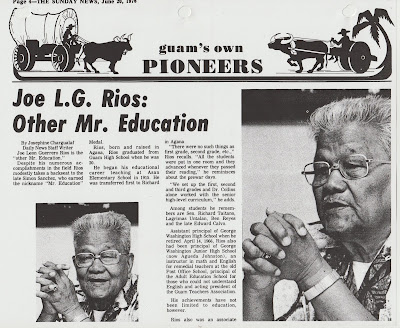A School With Any Other Name...
I used to have an assignment in my Guam History classes, where I would have my students visit different schools on the island named for a different local historical figure. They would have to interview an administrator and a teacher to learn how their school honored their namesake and how their namesake’s example or history was or wasn’t incorporated into school curriculum or activities.
Unfortunately, most schools did little in this regard. Some had a simple plaque, a statue, a poem or a song. Some had a day in which they would honor the person. Many of the schools are named for educators from the past century, usually in the village of the school that came to bear their name. Some teachers or administrators who had family ties in the village could share stories about their school’s namesake, but most didn’t know much and couldn’t share much.
I would give this assignment to help students understand the value of history, but also the potential uselessness of history. History isn’t a direct map. It isn’t a list of instructions to follow. History is only something useful if it is used, if it is investigated, if it is synthesized in such a way so that lessons from the past can be applied today. But if you don’t take that history seriously, you waste an easy, everyday opportunity to impart lessons and examples to the youth.
As someone who has taught Guam History, who studies it, writes about I, I always try to promote it. Each year when I visit different schools to do presentations or readings, I always try to share stories with teachers and students about who their schools are named after.
My daughter Sumåhi currently goes to Jose L.G. Rios, and much to her preteen chagrin, I am always telling her tidbits of stories that I've heard about her school's namesake. I scanned and emailed her last week a series of articles that I'd found about Jose Rios from before and after the war. I told her that she could always share with others about what she learned in the articles and even impress her teachers (even if her classmates may not care). Jose Rios was part of the first generation of Chamorus who got a chance to attend college in the US. He didn’t finish his degree, but he nonetheless became an important fixture in Guam’s prewar and postwar educational system.
Sumåhi, in middle schooler mode, texted back to me an “eye roll” emoji and the question “håfa bei cho’gue yan este?” (What am I supposed to do with this?). This is a conversation we have more and more lately as she develops her own interests and personality. As I share history, not just from Guam, but elsewhere, she regularly wants to know, why is it important that she know this? What does it matter?
I texted back, "Hunggan ti un agradedesi este på'go na tiempo gi sumoterå-mu, lao un diha siempre u matulaika I hinasso-mu. Mungga maleffa hagå-hu, i tiningo'-mu muna'kapås hao!" (Yes, you don't appreciate this now, but one day your attitude will change. Don't forget my daughter, your knowledge is what makes you capable) She texted me back two eye roll emojis and also a thumbs up - so at least some progress.





Comments